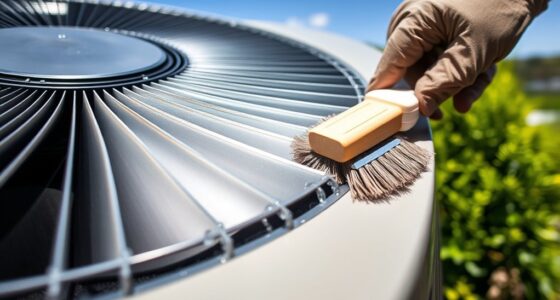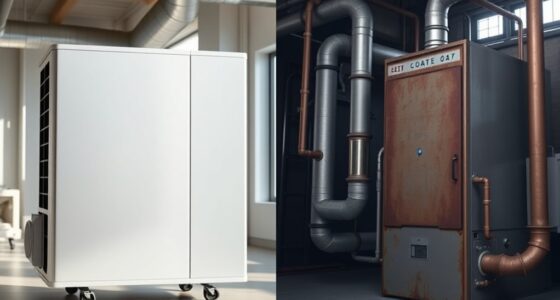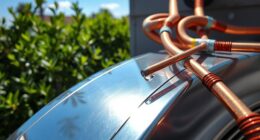In a hybrid heat pump system, your energy use depends on outdoor temperatures and how the system switches between the heat pump and backup heating. When temperatures are mild, the heat pump runs efficiently, saving energy. But as it gets colder, the system relies more on backup heating, increasing consumption. Factors like home size, insulation, and control strategies influence overall costs. To optimize performance and save more, understanding these variables helps you get the most from your system—there’s more to explore.
Key Takeaways
- Energy consumption varies based on outdoor temperature, with higher use during cold weather when auxiliary heating is needed.
- Hybrid systems optimize energy use by switching between heat pump and backup furnace based on real-time outdoor conditions.
- Proper system sizing, insulation, and regular maintenance improve efficiency and reduce overall energy consumption.
- Leveraging weather forecasts and real-time data allows proactive adjustments, minimizing unnecessary energy use.
- Integrating renewable sources like solar can significantly lower energy costs and consumption in hybrid heat pump setups.
How Hybrid Heat Pumps Balance Efficiency and Performance

Hybrid heat pumps balance efficiency and performance by intelligently switching between heat pump and traditional heating modes based on outdoor temperatures. When temperatures are mild, the system maximizes heat pump efficiency, often achieving efficiency ratings over 250%, which greatly reduces energy use. During colder weather, typically below 40°F, the backup heating activates to maintain consistent warmth. This seamless transition ensures you don’t sacrifice comfort when outdoor temperatures drop. By managing the switch between heat sources, the system optimizes energy savings without compromising performance. When outdoor temperatures fluctuate, the hybrid system adjusts accordingly, leveraging the heat pump’s efficiency during mild conditions and relying on backup heating during extreme cold. This balance helps you achieve significant energy reductions while maintaining reliable home comfort. Additionally, system tuning can further enhance the efficiency and responsiveness of hybrid heat pump systems, ensuring they operate optimally under varying conditions. Incorporating advanced controls allows for better management of system operation, further improving overall energy efficiency. Proper maintenance and regular system checks can also extend the lifespan and effectiveness of your hybrid heat pump, ensuring consistent performance over time. Regular system calibration can help ensure the system operates at peak efficiency and adapts to changing environmental conditions. Furthermore, understanding the energy consumption patterns can aid in optimizing your system’s settings for maximum savings.
Factors Influencing Energy Usage in Hybrid Systems
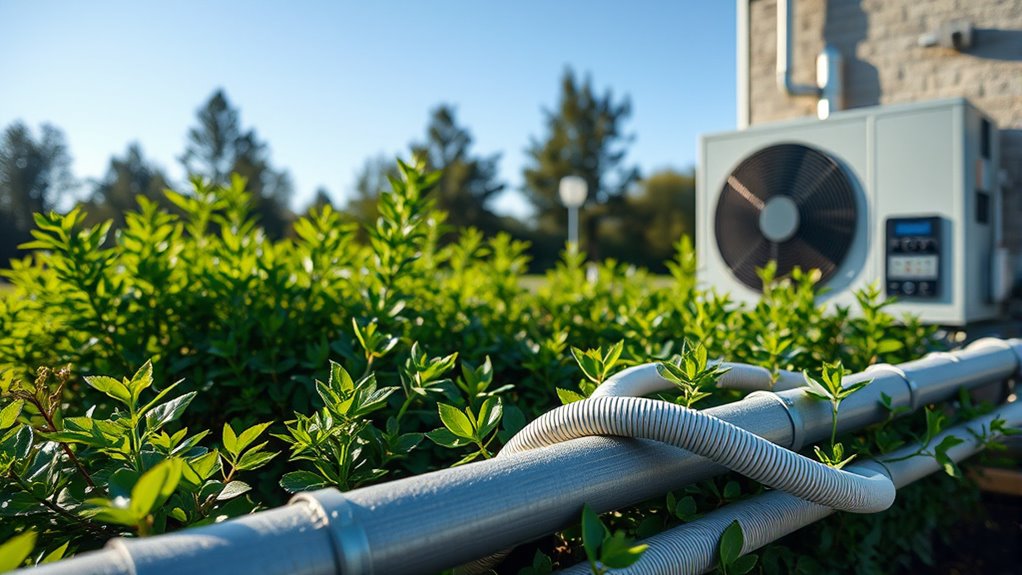
Your energy consumption with a hybrid heat pump system depends on several key factors. Outdoor temperatures greatly influence energy usage; colder weather increases reliance on backup heating and raises overall consumption. System efficiency, reflected in SEER and HSPF ratings, determines how much electricity your system uses during operation. The insulation quality and home size also matter—larger, poorly insulated homes require more energy to maintain comfort. During defrost cycles or when switching heating modes, peak power draw can reach up to 6.9 kW, impacting efficiency. Weather conditions and humidity levels cause fluctuations in energy consumption, affecting how effectively your system operates. Additionally, renewable energy sources like solar or wind can supplement your system, reducing reliance on grid electricity and lowering overall energy use. Proper system maintenance and regular servicing can further optimize performance and energy efficiency. Ensuring system components are up to date can prevent energy losses and improve overall operation. Regularly monitoring and adjusting system settings can also help optimize energy consumption based on seasonal changes. For example, implementing smart thermostats can enhance control over your heating patterns, further reducing energy consumption. All these factors combine to shape your overall energy use, highlighting the importance of proper insulation, efficient equipment, and ideal system settings.
Estimating Energy Consumption for Different Home Types
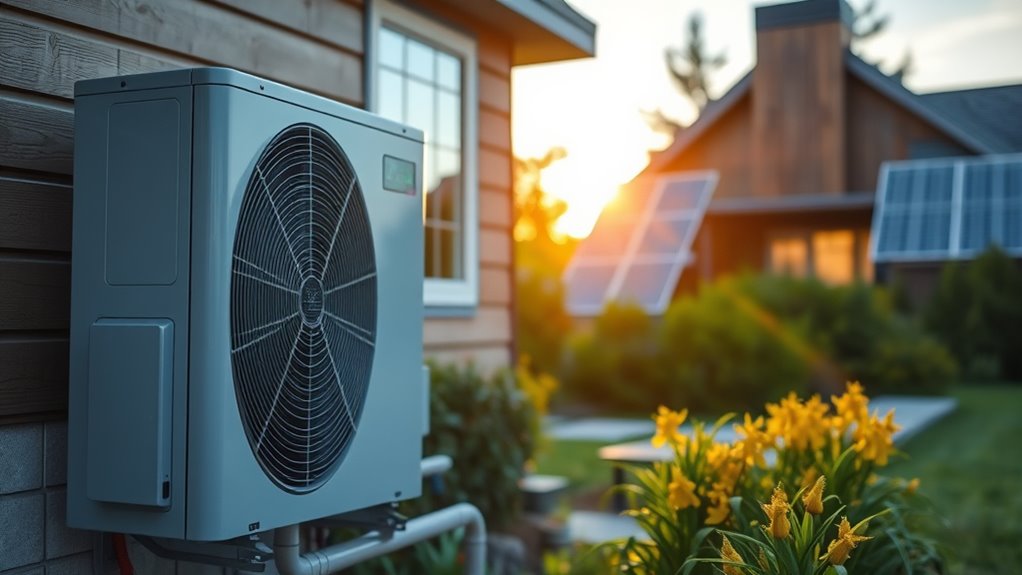
Estimating energy consumption for different home types involves considering factors like size, insulation, and climate zone, all of which substantially impact usage levels. Your home’s energy use depends on its characteristics, such as home size and insulation quality, which influence heating and cooling efficiency. In colder regions, hybrid systems tend to consume more energy due to increased backup heating needs during cold spells. To get accurate energy consumption estimates, you should analyze utility bills to understand actual energy use for heating and cooling. Regional climate and home features are key inputs for energy modeling, helping you predict how much energy your home may need annually. Remember, total utility bills include other electrical loads, so isolating HVAC costs gives a clearer picture of your home’s energy demands.
Power Demands and Electrical Requirements of Hybrid Heat Pumps
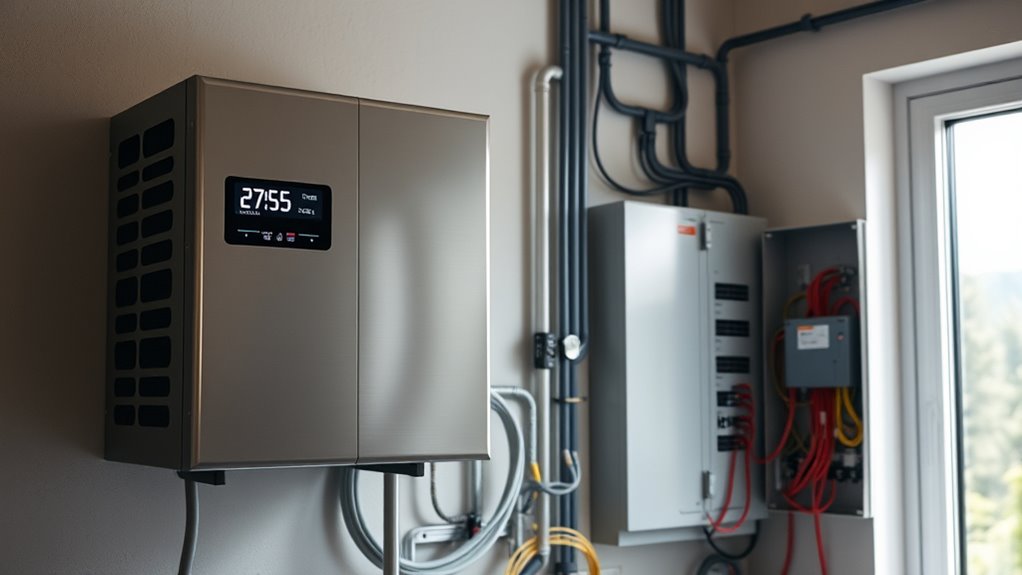
Understanding the power demands and electrical requirements of hybrid heat pumps is essential for proper system installation and operation. Your system’s power consumption varies based on factors like size, efficiency, and outdoor temperature. During operation, a hybrid heat pump can draw between 830 W and 6.9 kW, with peak demands reaching up to 7.5 kW during startup or defrost cycles. Proper sizing of your electrical setup ensures safety and ideal performance. Keep in mind:
- Circuit breakers typically range from 15 to 50 amps
- Larger units often need 40 amps or more
- Backup heating increases electricity use during cold weather
- System specifications, like BTU capacity and inverter technology, influence electrical requirements
- Power demands fluctuate based on outdoor conditions and system efficiency
Additionally, electrical load considerations are crucial to prevent overloads and ensure reliable operation. Regularly reviewing power consumption patterns can help optimize your system’s energy use and prevent potential electrical issues. Being aware of the efficiency of your heat pump can also impact its electrical demands, especially during seasonal changes. Moreover, understanding system performance can aid in troubleshooting and maintaining optimal energy usage. For example, smart controls can help monitor and adjust energy consumption in real-time. Accurately understanding these factors helps you meet your system’s electrical needs efficiently.
Impact of Outdoor Temperatures on System Operation
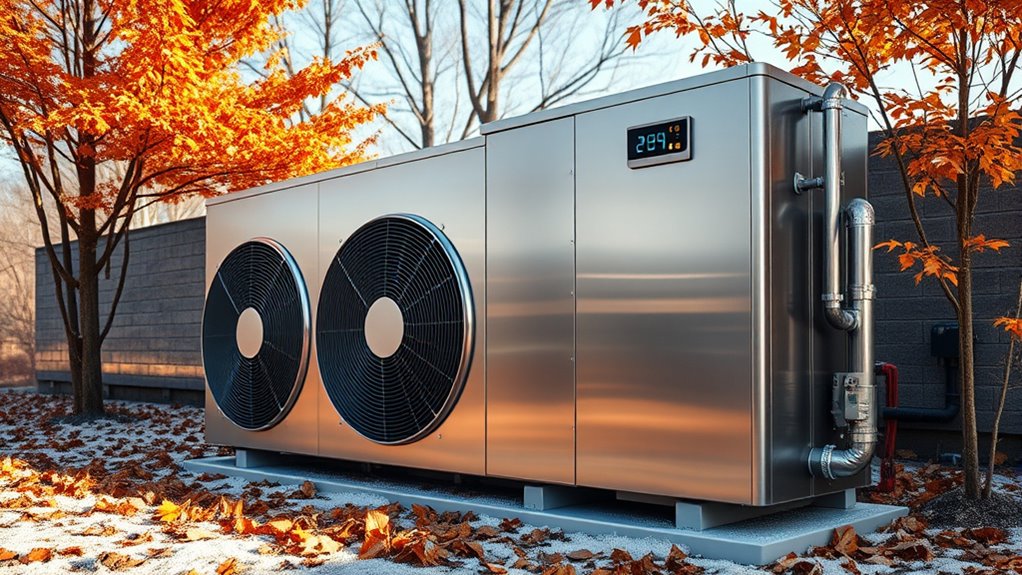
Outdoor temperatures have a direct and significant impact on how hybrid heat pump systems operate. When outdoor temperatures fall below 40°F, efficiency drops as heat pump COPs decline, leading to increased reliance on auxiliary heating. Cold temperatures below 20°F can reduce COPs further, sometimes requiring backup heat sources and raising energy consumption. Below -5°F, heat pumps often operate at COPs near 1.0, making them less efficient than traditional systems. These temperature changes affect system operation and reliability, increasing operation costs during cold snaps. Additionally, advancements in refrigeration cycle design and smart controls can help mitigate some efficiency losses during cold weather. Furthermore, temperature management strategies are crucial for maintaining optimal system performance and minimizing energy costs during extreme cold periods. Proper system sizing and outdoor temperature monitoring can also enhance efficiency and reliability in harsh winter conditions, especially when combined with system controls that optimize performance based on current outdoor conditions. Incorporating regular maintenance practices can further sustain system performance and prevent efficiency drop during prolonged cold spells.
Cost Implications and Savings Potential
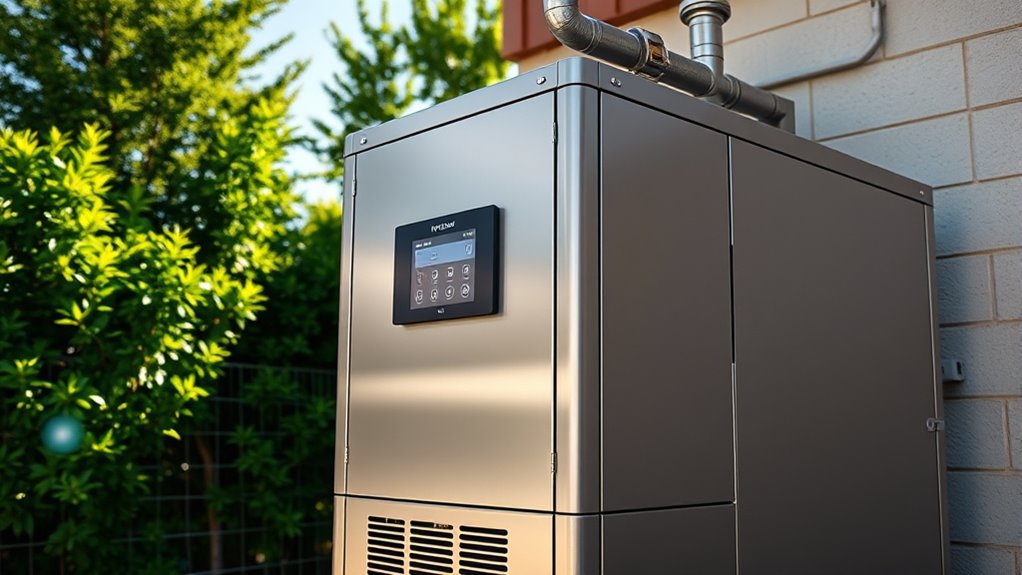
Installing a hybrid heat pump system can markedly cut your energy costs by optimizing when and how you use electric heat and traditional boilers. Over time, these savings can help you recover about half of your initial investment within 20 years, especially with favorable utility rates. By understanding these cost implications, you can make smarter choices for long-term energy savings and investment benefits. Additionally, awareness of cookie management policies can help you better control your online privacy while researching energy-efficient solutions. Being mindful of privacy and data management policies ensures that your personal information remains protected as you explore different heating options. Moreover, understanding how arcade machines operate can provide insights into energy-efficient hardware design, further supporting your efforts to reduce energy consumption. Considering the energy efficiency of different system components can lead to even greater savings over the lifespan of your heating system. Evaluating the performance of hybrid systems can also help optimize their operation for maximum savings and reliability.
Energy Cost Reduction Strategies
Implementing hybrid heat pump systems offers considerable opportunities to reduce heating costs by optimizing operation between the heat pump and backup furnace based on outdoor conditions and utility rate structures. To maximize energy efficiency and cost savings, focus on proper system sizing and control settings tailored to your utility rates. Using off-peak electricity allows the heat pump to operate more efficiently, achieving better COPs and lowering heating energy costs. Additionally, pairing your system with renewable energy sources like solar can further reduce expenses. Strategies include:
- Adjusting control settings for peak and off-peak periods
- Sizing the system appropriately for your home
- Leveraging utility rate structures for cost savings
- Utilizing off-peak electricity for better efficiency
- Integrating renewable energy options for additional savings
Incorporating energy consumption patterns into your system management can also help identify optimal operating times and further enhance savings. Recognizing the seasonal variability of energy demand can help tailor your system’s operation to maximize efficiency and savings. Understanding Gold IRA options and how they relate to energy investments can guide long-term financial planning. These approaches can lead to annual energy savings of 20-30%, considerably reducing your overall energy costs.
Long-term Investment Benefits
Investing in a hybrid heat pump system can yield significant long-term savings, often recovering about half of the initial costs within 20 years through energy reductions. This investment not only lowers operational costs but also boosts energy efficiency, especially when integrated with renewable energy sources. Deep retrofit scenarios can achieve primary energy reductions of around 70-72%, amplifying long-term cost benefits. Pairing hybrid systems with solar power further enhances savings by reducing electricity expenses. The financial benefits include lower operational costs, incentives or rebates, and reduced greenhouse gas emissions. Here’s a comparison of key factors:
| Aspect | Benefit |
|---|---|
| Initial capital | Higher upfront, but recovers over time |
| Long-term savings | Significant energy savings and reduced costs |
| Retrofit and renewables | Maximize energy efficiency and cost benefits |
This makes hybrid heat pumps a smart, sustainable investment.
Strategies for Optimizing Energy Consumption in Hybrid Systems

To optimize energy consumption in hybrid heat pump systems, focusing on control strategies and system management is essential. You can enhance system efficiency by:
- Using advanced control strategies that switch between the heat pump and backup furnace based on outdoor temperature and demand
- Regularly maintaining filters, refrigerant levels, and components to prevent energy waste
- Leveraging weather forecasts and real-time temperature data for proactive adjustments
- Integrating energy monitoring systems to track and analyze consumption patterns
- Designing systems that maximize performance and minimize backup furnace reliance
Frequently Asked Questions
How Much Electricity Does a Hybrid Heat Pump Water Heater Use?
You might wonder how much electricity a hybrid heat pump water heater uses. Typically, it consumes between 1,000 and 3,000 kWh annually, depending on your household size and usage. During operation, it draws about 300 W to 1.5 kW, with peak power at 1.5 kW. Overall, it’s quite efficient, often reducing energy use by up to 60% compared to traditional electric water heaters.
How Many Kwh Does a Heat Pump Use in a Day?
You’re curious about how much energy a heat pump uses daily. Typically, it consumes between 15 and 35 kWh, but that varies with outdoor temperature, home size, and usage. During moderate weather, expect about 12 to 84 kWh in 24 hours. Colder days can push this over 50 kWh, especially if auxiliary heat kicks in. Monitoring your system gives the most accurate readings for your specific situation.
Why Is My Electric Bill so High With a Heat Pump?
Your electric bill might be high because your heat pump uses a lot of energy, especially during startup or in very cold weather when backup electric heaters kick in. If your system is oversized, poorly installed, or not weatherized well, it works harder and consumes more power. Additionally, high electricity rates or peak pricing can make your energy costs spike, leading to that unexpectedly high bill.
How Efficient Is a Hybrid Heat Pump?
A hybrid heat pump can be quite efficient, often achieving over 200-250% in real-world conditions, meaning it provides more heat per unit of energy than traditional systems. Its efficiency peaks during milder weather when it mainly runs the heat pump, but drops when it switches to backup heating in colder temperatures. Proper installation and system design help you maximize efficiency and save energy throughout the year.
Conclusion
As you navigate the maze of energy choices, envision your hybrid heat pump as a symphony of efficiency and performance, harmonizing with outdoor temperatures like a seasoned conductor. By understanding the factors at play and optimizing your system, you’ll transform your home into a sanctuary of comfort that gracefully balances cost and energy. Embrace this dance of technology and nature, and watch your energy consumption become a seamless, elegant rhythm that sustains both your home and your savings.


